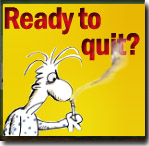|
COUNTY OF SAN DIEGO HEALTH AND HUMAN SERVICES
...Smoking ban means: “Smoke-free living”
...There was once a time when cigarette smoke was everywhere. People were able to smoke in restaurants, bars, offices, stadiums, beaches, parks and on airplanes. Over the years, a successful movement evolved to significantly curtail smoking and preven ‘We were surprised to discover that being within a few feet of a smoker outdoors may expose you to air pollution levels that are comparable, on average, to indoor levels that we measured in previous studies of homes and taverns,’ said Wayne Ott, consulting professor of civil and environmental engineering at Stanford and co-author of the JAWMA study. “For example, if you're at a sidewalk café, and you sit within 18 inches of a person who smokes two cigarettes over the course of an hour, your exposure to secondhand smoke could be the same as if you sat one hour inside a tavern with smokers. Based on our findings, a child in close proximity to adult smokers at a backyard party also could receive substantial exposure to secondhand smoke.” “The closer you are to an outdoor smoker, the higher your risk of exposure.” This is just one of the reasons why researchers feel that it is important to curb outdoor smoking as well as smoking indoors. There are other reasons why people are now trying to stop smoking in outdoor environments. Children’s curiosity can put them at risk. Children will pick up cigarette litter at home, parks and beaches. The Centers for Disease Control and Prevention (CDC) studied 146 children aged six months to two years who had ingested cigarettes or cigarette butts.One third of them experienced illness. The most common symptom reported was spontaneous vomiting. Most ingestion occurred in homes where children were exposed to smoke and where cigarettes and ashtrays were kept within the reach of children. The study also found the following: • Children in households where cigarettes were smoked in their presence were four times as likely to ingest cigarettes or cigarette butts as children in households where smoking does not occur around children. • The ages of children who had ingested cigarettes or cigarette butts were 6-24 months. Among children who had ingested cigarettes or cigarette butts the highest number of exposure occurred among children aged 6-12 months (76.7%). • A third of children who ingested cigarettes or cigarette butts developed symptoms. Of those, 87 percent developed spontaneous vomiting. Other symptoms included nausea, lethargy, gagging, and a pale or flushed appearance. • Fire Risks Careless smoking is estimated to be the number one cause of fire related deaths and injury in the nation. The majority of these cases involve indoor smoking and careless extinguishing of smoking materials, but many of these fires are the result of discarded cigarettes, whether tossed out of a car or thrown on the ground by pedestrians and by standers. • Toxic Pollution What happens after that butt gets casually flicked onto the street, nature trail, or beach? Typically wind or rain carry the cigarettes into the water supply, allowing toxic chemicals within the cigarette filter to leak out into the aquatic ecosystem, threatening the quality of the water and many aquatic life forms. Cigarette butts may seem small, but with the liter of several trillion butts littered every year, the toxic chemicals add up! Ordinances banning smoking in parks and beaches reduces/eliminates cigarette litter. Quitting Smoking is the number one solution "Smoking remains the number one cause of preventable death and disease," Dr. Mark Horton, Director of the California Department of Public Health said. "The California Smokers' Helpline is a valuable resource that can help the states nearly 4 million smokers become tobacco-free." Launched in 1992, the California Smokers' Helpline was the nation's first statewide telephone counseling service. Since its debut, the Helpline has provided free and confidential statewide telephone counseling services to nearly 430,000 Californians from diverse communities throughout the state. Quitting assistance is offered in English, Spanish, Mandarin, Cantonese, Vietnamese, and Korean as well as TDD for the hard of hearing. California leads the way in providing legislation that bans smoking in public buildings, restaurants, bars and public recreation areas. Other cities, counties and states are moving toward introducing smoke-free living environments. "We have come a long way in reducing the number of smokers in California, but there is more work to do," Dr. Mark Horton, said. Further information about the California Smokers' Helpline is available at: |
||
TEL- 619-427-4111 Email - Health@infooption.com Salud+HealthInfo is for information and educational purposes only. You should not rely on this information as a substitute for personal medical attention, diagnosis or hands-on treatment. If you are concerned abut your health or that of a child, please consult your family's physician or health provider immediately and do not try to diagnose yourself. Copyright © 2001-2008 Info Option Network |
||
Bienvenido a la primer revista dedicada al cuidado de la salud
 info
info
The first, the best & the only English & Spanish Magazine in San Diego, California
CALL 1800-NO-BUTTS |
|
| Mission Possible:Quit Smoking Today | |
SMOKE FREE LIVING |
|
Smoking ban means: "Smoke Free Living" |
|
| ESPAÑOL | |
| Smoke Free Polices and Heart Attack (UCSD) | |
|
|
|
|
|
|
U.S.Surgeon General's Report on Effects of Second Hand Smoke |
|
|
|
|
|
|
|
American Celebrities whose lives were shortened by tobacco use. |
|
|
|
|
|
Two years old and smoking Hooka! Send your comments |
|
|
|
|
|
| California gets mixed grades in fight against leading cause of death | |
| • More related info | |
| Underage Drinking | |
| Before is Too Late:Get Off Meth | |
| Mental health services are available | |
| Fire Prevention (Red Cross | |




